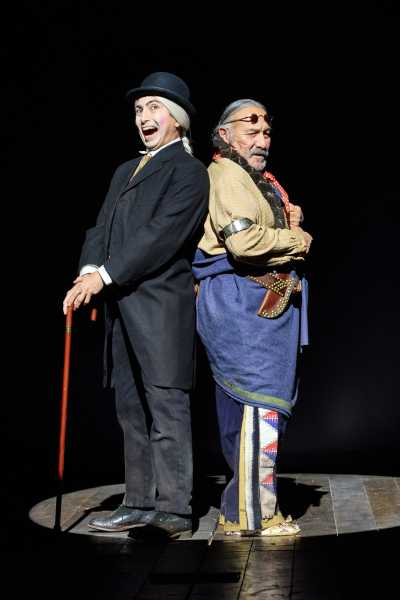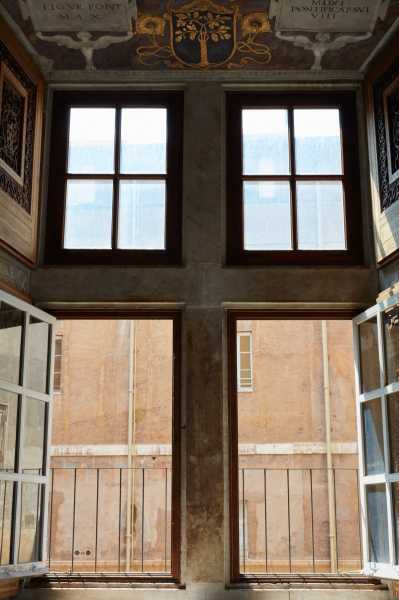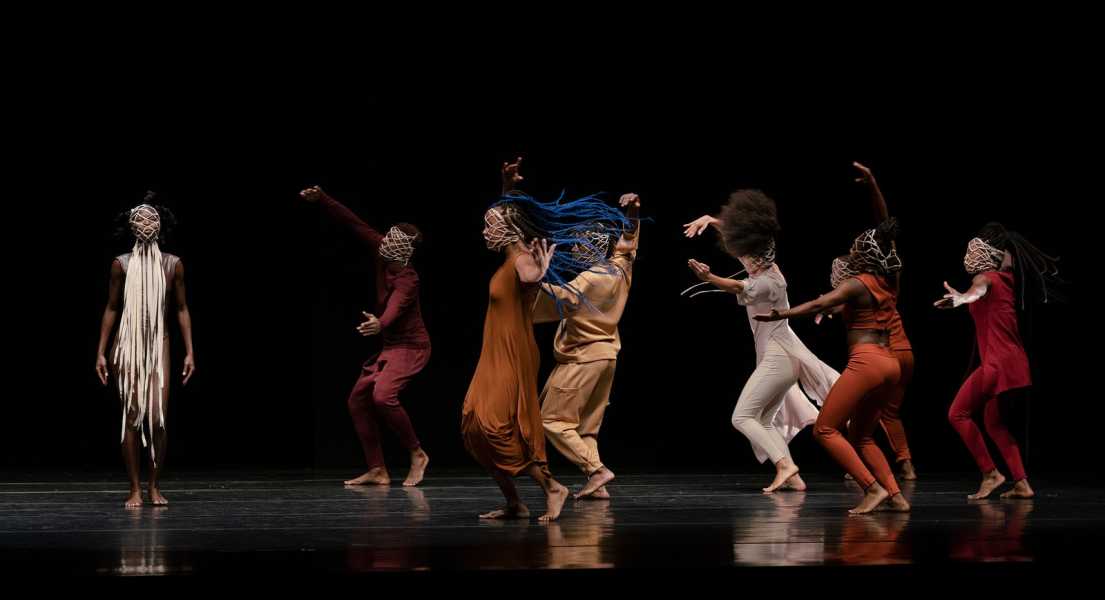
Save this storySave this storySave this storySave this story
Helen Shaw
Staff writer
You’re reading the Goings On newsletter, a guide to what we’re watching, listening to, and doing this week. Sign up to receive it in your in-box.
If you follow the eddy of the New York theatre season, you may already know that March and April will be a scrum on Broadway. Eighteen shows open in seven weeks, all scrambling to find their way along the slippery rocks before the Tony deadline of April 25. But, dazzled by that Broadway bustle, you might have missed that there’s already a spate of productions Off Broadway, making February hum in a way that our theatre hasn’t in quite some time. It’s the perfect moment to see odd and discomfiting shows, all deliberately and riotously strange.
The Perelman Performing Arts Center, the big marble cube downtown, has mounted its first mainstage theatre piece: the vaudeville “Between Two Knees,” by the 1491s, a comedy ensemble of self-described “indigenous misfits.” The show’s title refers to two bitter conflicts at Wounded Knee—the 1890 slaughter by the U.S. Army and the American Indian Movement’s seventy-one-day occupation of the town near the site, in 1973—but the mood in this lazy-day, cartoony retelling of three generations of Native American suffering remains darkly humorous. The worse things get, the more the company makes zany jokes; the 1491s started out posting videos of weird sketches online, and even now a loose, we’ll-fix-it-in-the-edit spirit pervades the piece.

“Between Two Knees,” at PAC NYC.
Photograph by Jeremy Daniel
I’m still grappling with the extraordinary “I Love You So Much I Could Die,” Mona Pirnot’s brief solo show at New York Theatre Workshop, a monologue in which the playwright, who also performs, basically refuses to say anything. For the hour-long concert-event, directed by Lucas Hnath, Pirnot has her computer “read” us her script using its text-to-speech program, while she sits with her back to us, sometimes picking up a guitar to play a song, but never turning around. For the most part, we stare at the back of her head, and its long fall of blond hair, as a robotic voice recites a confessional text about illness and grief. Bizarrely, this demonstration of disembodiment is extremely frightening. Even now, I can see the back of Pirnot’s head, blank as a cushion; if I close my eyes, it seems to be staring at me still.
Also emotionally punishing—if less innovative—is Corinne Jaber’s “Munich Medea: Happy Family,” at the Women’s Project. I’m still trying to work out if I should recommend it to anyone, because its relentless, downbeat, grim-faced nature is such a difficult thing to invite into people’s evenings. Three connected monologues eventually braid together into a horrible story about a sixteen-year-old girl in Munich who enters a sexual relationship with her friend’s father. The connection to Euripides’ ancient “Medea” is opaque: it’s unclear which of the two shuddering women—now grown, but not healed—is meant to remind us of Euripides’ vengeful monster-heroine. You certainly yearn for them to strike out at their tormenter, who sits in a dressing room on the set’s second level, but he remains impervious.
Maybe we’re in a post-“Euphoria,” the kids-are-not-all-right boom, but one of the best performed shows in New York right now, “you don’t have to do anything,” in the microscopic basement space at HERE, also deals with sexual coercion and the slippery nature of identity combined with trauma. Ryan Drake’s script, exquisitely directed by Ryan Dobrin, seems like a straightforward memory play, with Yaron Lotan in the role of a seventh grader, Teddy, who has a dangerous friendship with a weird older kid, played by Will Dagger. As he talks, Teddy hints that he’s massaging the truth, but Dagger is clearly the bigger creep—his insinuating softness makes you feel like you’ve accidentally touched a rat.
All four pieces, now that I think about it, ask the same questions: If something terrible happens to you, must you root out its influence? What else will you destroy if you do? The answer is frightening in each piece, but oddly galvanizing, too. At the end of “Between Two Knees,” for instance, the company sings about their hope that white people would just disappear. All that Indigenous folks need is a little act of wish-fulfillment ethnic cleansing! The actors wave their hands back and forth over their heads, and the PAC NYC theatregoers—white patrons included—laugh and wave along. “Some of you were cool,” the whole room sings, sort of to itself. “Most of you were not.”
Spotlight

Photograph by Matthew MurphyBroadway
Around a decade ago, the Pigpen Theatre Co., a seven-man theatrical collective and band, made a stir with its banjo-forward, Mumford & Sons-esque music, breaking through with lo-fi shows such as “The Old Man and the Old Moon,” a sweet folktale from 2012 told with lamplight and shadow puppets. Now the company is back, composing songs for the much brighter lights of Broadway, joining the book writer Rick Elice to adapt Sara Gruen’s Depression-era romance, “Water for Elephants,” from 2006, in which a veterinarian runs away and joins the circus. Shana Carroll, of the Montreal acrobatic troupe Les 7 Doigts de la Main, designs the show’s circus choreography, which guarantees a certain lighter-than-air quality; Grant Gustin, of “The Flash,” plays the sawdust-struck newcomer, and Isabelle McCalla (pictured) plays his aerialist love.—Helen Shaw (Imperial Theatre; in previews.)

About Town
Folk
The New Orleans-based folk rocker Alynda Segarra has been a patron saint of troubadours for fifteen years, as the front person for Hurray for the Riff Raff. They left the Bronx at seventeen to escape a fractured home life, hopping trains and exploring the U.S. Their music embodies those travels, exploding Americana traditions and speaking for those marginalized by society. The 2014 song “The Body Electric” revealed the band’s full potential—its sharp sendup of the murder ballad displayed Segurra’s smoky voice and striking authorship, and the singer-songwriter has grown even bolder since. The group’s new album, “The Past Is Still Alive,” recorded in the wake of Segarra’s father’s death, continues a mission of record-keeping for outcasts, including those memories closest to home.—Sheldon Pearce (Music Hall of Williamsburg; March 5.)
Classical Music
A Far Cry, a Boston-based chamber orchestra of vigor, sensitivity, and shared concentration, operates in egalitarian ways: its members play without a conductor, vote on their programs, and rotate artistic leadership. On March 2, the ensemble finds a beautiful metaphor for its organizational model in the concerto grosso, a Baroque form in which multiple soloists spin glittery lines in dialogue with a larger unit of players. The program includes modern examples by Ernest Bloch and Errollyn Wallen, which combine a fresh harmonic sense with Baroque elements such as the fugue and ground bass. The next day, A Far Cry invites attendees to delve into its artistic process as equal partners in an interactive listening session.—Oussama Zahr (Kaufman Music Center; March 2-3.)
Art

“Untitled #17 (Windows),” 2023.
Art work © Catherine Opie / Courtesy Regen Projects / Lehmann Maupin
In her latest photographs, Catherine Opie takes us on another tour of a solemn sadomasochistic subculture, except that this time it’s the Catholic Church. For the two most striking images in the exhibition “Walls, Windows and Blood,” she assembles closeups of Christ’s gushing wounds, all taken from medieval and Renaissance paintings and all marked by a bold androgynous eroticism. The kinkiness of Christian iconography may be more of a cliché than an insight at this point, but Opie’s eye is so keen that she can walk around Vatican City photographing the most banal-seeming subjects—a red banner, a wall missing a few bricks, a window with a cross running up the middle—and give them a suggestive tingle.—Jackson Arn (Lehmann Maupin; through March 12.)
Off Broadway
Ana (the charismatic Gabby Beans) is a clever, capable young woman, perched on the edge of becoming. Her encounters with three male figures make up the dreamlike texture of “Jonah,” a new play by Rachel Bonds, directed by Danya Taymor, for Roundabout Theatre Company. The show opens on Ana meeting Jonah (Hagan Oliveras) at a boarding school. Jonah is sweet and sensitive—the kind of boy that a certain kind of girl dreams of holding in a healing embrace. Ana encourages him, just as she does her off-putting stepbrother, Danny (Samuel H. Levine), with whom she has a more troublingly complicated relationship, and, later on, a fellow-writer at a residency, Steven (John Zdrojeski). On a claustrophobic one-room set, “Jonah” asks, through a symphonic structure, what are the costs of this sort of intimacy?—Vinson Cunningham (Laura Pels; through March 10.)
Dance

Photograph by Marcela Gómez
For those unaware or in need of a reminder that the African diaspora extends to Colombia, the dancers of Sankofa Danzafro are ready to teach, not didactically but through poetic embodiment. In the new piece “Behind the South: Dances for Manuel,” they take inspiration from the anthropologist Manuel Zapata Olivella and his epic novel “Changó, el gran putas.” Like the book, the work touches on the arrival of African people to the Americas and the spiritual beliefs that they brought with them, but the company expresses those beliefs in drumming, song, and supple, subtle dance. The guiding spirit is less Changó, the god of fire, than Yemaya, the mother who heals.—Brian Seibert (Joyce Theatre; Feb. 27-March 3.)
Movies
The first feature by the Japanese filmmaker Shiori Itō, “Black Box Diaries,” will have its New York première at MOMA on March 6, as part of the annual “Doc Fortnight” series, which runs Feb. 22-March 7. Itō, a female journalist, accused a powerful elder male reporter of raping her, in 2015; two years later, when prosecutors refused to bring charges, Itō went public with her accusations, filed a civil suit against the reporter, and launched an investigation of her own, which she documents in the film. Itō shows in harrowing detail the surveillance and the threats that she endured, the intrepid maneuvers she undertook in pursuit of the truth, and the high personal price of her efforts, which have been credited with sparking Japan’s own #MeToo movement and changes to the country’s laws regarding rape.—Richard Brody

Pick Three
The staff writer Amanda Petrusich shares current obsessions.
1. Best Instagram account to browse while you dutifully eat kale: One could never in good conscience recommend smoking—the risks are real, gnarly, assured—but it’s impossible to deny that, from an aesthetic perspective, the act itself is perversely alluring. This is the founding principle of Cigfluencers, which posts photos, new and old, of hot and famous people smoking while looking hot and famous.
2. Best podcast for pretending that you’re still cool: The central pleasure of the smart, irreverent, and gleefully indecorous podcast “How Long Gone,” hosted by the old buds and “bicoastal élites” Chris Black and Jason Stewart, is that it makes its listeners feel as if they are privy to the travails and micro-beefs of the creative class, even if they’re not spending their mornings sipping fourth-wave coffee or nibbling toast at Balthazar. The show has its own rhythm and slang, and Black and Stewart have an easy, confident rapport. Their interviews—with writers, musicians, artists, and fashion types—are often revelatory.

Illustration by Jam Dong
3. Best way to drop a hundred dollars and feel great about it: Record stores. Streaming is a convenient way to hear music, but it inevitably creates a gaping hole in your soul. One antidote is to ditch the algorithm for some good old-fashioned manual curation: if you Venmo the End of All Music, a record store in Oxford and Jackson, Mississippi, one of the shop’s employees will send you a box of records, handpicked and nearly guaranteed to be great. Or just wander into your local shop and ask a clerk what’s good. I’ve never once regretted it.
P.S. Good stuff on the Internet:
- An essay on the personal essay
- Reviews of “Madame Web” on Letterboxd
- A profile of the dog from “Anatomy of a Fall”
Sourse: newyorker.com